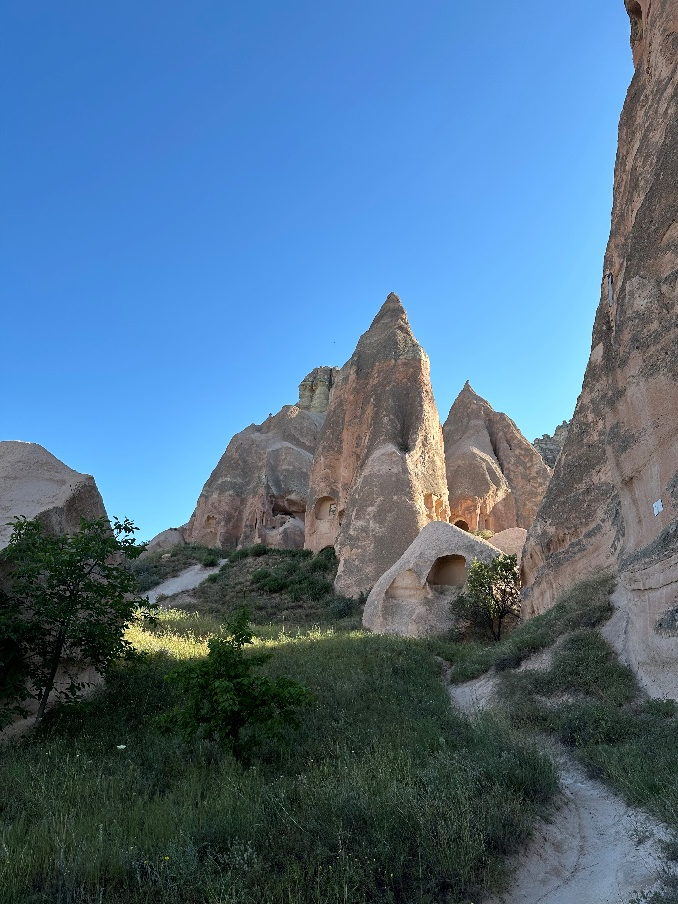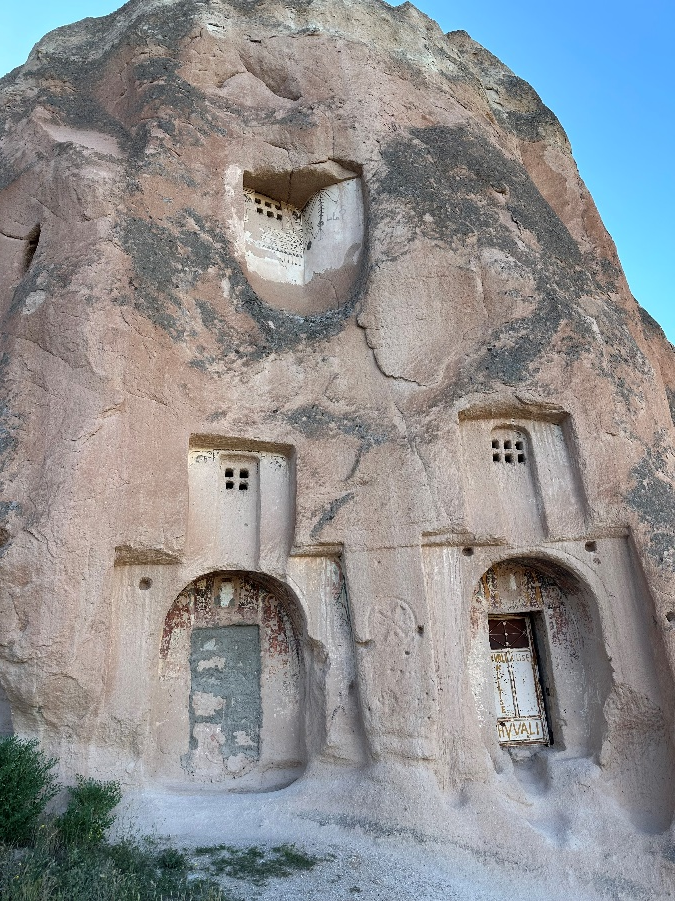General Information
Ayvalı Church
Ayvalı Church is located on the eastern side of Güllüdere Valley, approximately 1 km south of Çavuşin Village. It is situated within a rock mass north of the path leading past the Three-Cross Church (No. 3, Saint Agathangelus) (Yaşar, 2019; Türker, 2008).
The structure, accessed by passing through the riverbed to the left of the Three-Cross Church (Üç Haçlı Church) and through a tunnel, was carved into a cone-shaped rock formation (Türker, 2008: 28; Şen, 2019: 58). "Churches in the Cappadocia Region, dated between approximately 850 and 950, were first categorized as 'Archaic Group Churches' by Jerphanion, a classification later adopted by other researchers. Ayvalı Church, one of the Archaic group churches, is dated to the reign of Emperor Constantine VII Porfyrogennetos (913-920/945-959), between 913-920 according to its inscription
Plan Description: "“Ayvalı Church has a rectangular plan close to square in the north-south direction and two naves. The present entrance is located to the west of the south nave. The background of the scene, which is limited by a red-brown band from above and below, is green. The scene has been visibly deteriorated. Jesus is seen in the center of the scene, Adam and Eve on the right, King Solomon and King David busts on the left” (Yaşar, 2019: 70)." (Yaşar, 2019: 70).
Exterior Description: Ayvalı Church was carved into a cone-shaped rock formation (Photo 1).
Interior Description: "In addition to its two naves, the church also contains a winery located in the lower chambers on the south side and arcosolium tombs on the north side. Above the northern nave, there is a rectangular chamber measuring approximately 5.2 meters by 2.6 meters, with a carefully carved cross in the ceiling. This chamber has survived in its original state and was accessed through an east-facing doorway, now walled up. Today, entry to the chamber is via a roughly carved passage in the vault of the northern nave. Just north of this area, remains of another small chapel (Güllüdere No. 5 Church) and several tombs surrounding it can be found. Between these two churches, ruins of additional rock-hewn rooms have survived. This site may have served as a place of seclusion, with the upper chamber possibly functioning as a monk’s cell. It is also plausible that this area was later converted into a small monastery. The fragmented dedicatory inscription in Ayvalı Church references the Panagia and All Saints Monastery, built by the church’s founder. Although some researchers have suggested that this monastery was located elsewhere, it is also possible that the cluster of spaces around Saint Ioannes constitutes the mentioned monastery" (Ousterhout).
"A bird's nest has been identified in the lamp niche of Ayvalı Church, where birds enter through open spaces. The cavities carved into the rock surfaces for collecting pigeon guano have caused both structural and aesthetic problems. The fact that these cavities open into the church’s interior has facilitated pigeons settling within the structure. The nitrate (NO3) salts found in bird droppings have led to chemical deterioration of the building materials" (Şen, 2019: 162).
Decorative Description: "Ayvalı Church contains two Old Testament scenes, twenty-four New Testament scenes, three symbolic scenes, and one hundred and nine individual figures" (Türker, 2008: III). "The inscription of the two-naved, two-apsed Ayvalı Church provides information regarding its patron and the individual responsible for the second layer of wall paintings. The church is dated to 913-920 AD based on an inscription located on the arch of the arcosolium on the northern wall of the northern nave. This inscription, which is the second layer of paintings constituting the primary mural program, is written in a single line in white paint" (Türker, 2008: 30).
"In Güllüdere Ayvalı Church (913-920), a scene is depicted on the northern wall of the northern nave’s burial chapel. The depiction of the scene in the burial chapel serves as evidence that the individuals interred here were honored with the same incense ritual as a censer" (Altun, 2020: 120).
"The wall paintings of Ayvalı Church reflect the iconographic characteristics seen in pre-Iconoclasm Syrian-Palestinian works, influences from the capital, and the 'local' painting traditions of the Cappadocia Region. Ayvalı Church's wall paintings show stylistic similarities with archaic period churches, incorporating both local features and artistic influences from major production centers of the period" (Türker, 2008: VI).
"The painting program of Ayvalı Church includes one hundred and twenty-nine individual figures, ninety-two of which are identifiable by name, while thirty-six remain unreadable. The repertoire consists of depictions of saints, female saints, martyrs, female martyrs, monks, and bishops. The northern nave, which contains scenes related to the cult of veneration, predominantly features depictions of monks, bishops, martyrs, and female martyrs. Individual figures are placed on walls, niches, and entrance areas. A depiction of Pantocrator Christ is located on the inner surface of the arch at the northern entrance, while a throne-seated depiction of the Virgin Mary and Child Christ appears on the eastern vault pediment of the southern nave. Two independent depictions of archangels are painted on the western wall of the northern nave" (Türker, 2008: 195).
"The painting program in the southern nave is organized into two narrative registers on the vault, with a third register continuing along the upper sections of the lower walls. The vault is divided into sections by a large-scale Ascension scene covering its western part, while the remaining areas feature standard scenes from Christ’s Childhood. The mural sequence begins with the Baptism scene. The scenes from Christ’s Adulthood are entirely omitted, transitioning directly to the Passion cycle and concluding with the Anastasis scene. The Transfiguration scene is depicted on the western vault pediment, while the eastern wall features the Theotokos and Child Christ, accompanied by angels. Individual saint figures are painted within niches and along the lower sections of the walls. The narrative is densely composed, and due to the penetration of an older layer of paint into the upper layers, along with the accumulation of soot deposits over time, the readability of the paintings has diminished" (Ousterhout, 2019: 293).
Despite being generally well-preserved, structural cracks in the rock mass of Ayvali Church have caused significant instability in the building’s structure. Currently closed to visitors, the entrance of Ayvali Church is secured by an unaesthetic metal door and an unprotected hanging lock. The cavities carved into the church walls to collect pigeon droppings have damaged the wall paintings (Photo 2).
© 2025 Digital Cappadocia. All rights reserved. Unauthorized use of this content is prohibited.
How to get there?
Güllüdere 2 Vadisi, Çavuşin Köyü, Avanos, Nevşehir


